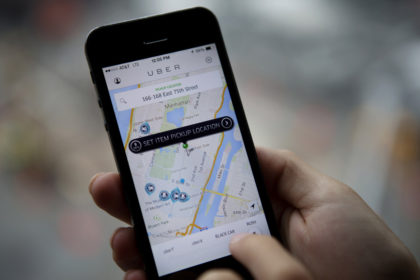
Uber at the Touch of a Button
Tuesday morning would be a good day to avoid travel through downtown San Jose. Two unions that represent taxi drivers are planning a protest to begin at 9:00 am at Parque Central. Instead of targeting the Solis administration, drivers will converge on the constitutional court and likely bring eastern San Jose to a stand still.
According to the leader of the Unión de Taxistas Costarricense, Uber collects more than 100 million colones in monthly revenue from activity it describes as “pirate”. The nation’s highest court, however revoked any means of enforcement when it declared as unconstitutional the public transportation law. The decision set the clock back by more than a decade, on negotiations between public transportation providers and the government. Understandably, taxi drivers are upset because Uber, like any disruptive new technology has the potential to put many out of work permanently.
Turf War
Having a license to operate a taxi in Costa Rica is far from a guarantee of financial success. Competition is fierce, and drivers spend much of their time waiting for work. Traditionally the most successful drivers are members of collectives that control territory in front of important public buildings, such as hospitals, airports and large hotels. Membership in a collective is limited, and drivers have been known to use violence and intimation to keep away drivers who are not members of the collective.
Uber is a big threat to the taxi collectives because it makes their hard fought territories worthless. A collective member could wait their turn for hours, all the while watching customers with smartphones hop into private vehicles, ignoring the taxi drivers completely. Taxi drivers that work territories have probably noticed that their take home pay is declining every day.
A Better Substitute for a Taxi
Uber isn’t a taxi service. Traditionally speaking Uber works like a private transportation company where customers call and ask to arrange a pickup. In the past however, such an approach has not been very convenient. Inexpensive smartphones, pervasive mobile Internet and GPS have changed the game completely.
Instead of walking to a busy intersection or going into the rain or curbside to hail a taxi, an Uber customer can sit comfortably in their home, wait in a building lobby or just continue to sip coffee while pressing a button on their phone. There is no need to talk to anyone, find a telephone number or as a foreign visitor actually communicate in Spanish.
If the customer can pinpoint their destination on Google Maps, then GPS does most of the rest of the work for them. Businesses owners, especially those that cater to tourists should make sure their Google Maps location is correct. Otherwise, their business is invisible to a growing market of smartphone users with disposable income.
Going out at night is especially easy with Uber because it’s a cashless transaction. The Uber App charges the credit card number on file at the end of the ride. A complete GPS record of the trip is retained with Uber, and the company is often willing to adjust the amount paid if the driver took an extraordinary, longer than appropriate route. Customers can also sit comfortably inside their favorite bar or night spot, ignore the taxi drivers that frequent the curb and step onto the street only after their Uber has arrived.
Customers Choose Which Drivers Earn
Perhaps the biggest problem for taxi drivers is that customer reviews ultimately determine who gets to work. Uber drivers who rack up too many poor reviews receive less work and may ultimately get booted from the platform entirely. Taxi union leaders in Costa Rica have described this characteristic as a violation of their constitutional right to work.
San Jose Traffic Woes
President Luis Guillermo Solís has declared that Uber and multinational companies have no regard for the social problems they create in countries like Costa Rica. Despite having sympathy for the taxi drivers and their union, it’s unlikely the government can afford to ignore traffic problem in San Jose. Solís made it an actual campaign promise to improve public transport and reduce traffic in San Jose. Recently the public has been putting pressure on the administration to deliver on that promise.
Uber at the very least is likely to take empty taxis off the streets. If the protests by the taxi drivers are a problem now, then they may be less in the future. With its rate of growth, Uber could replace a large percentage of red taxis in the coming year. Fewer taxis would mean smaller protests.